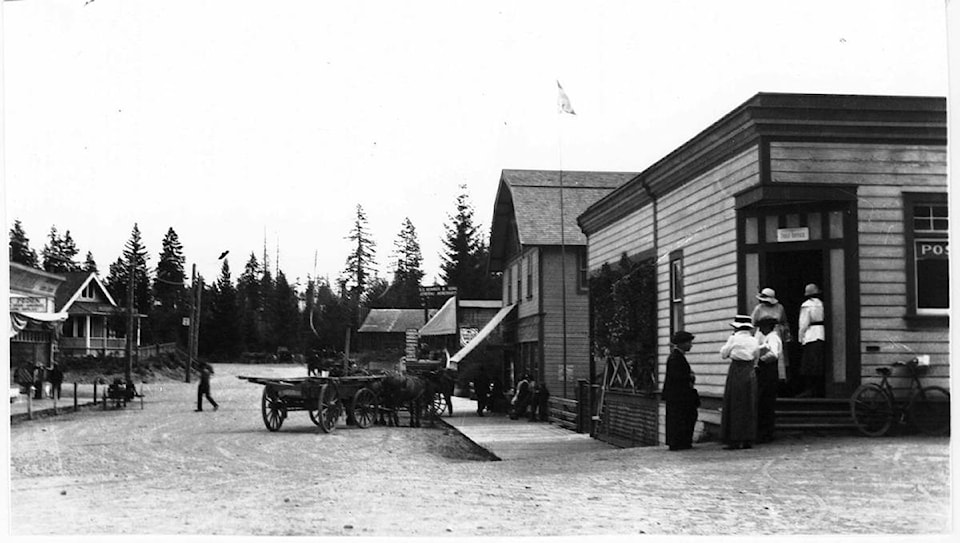“I looked round and suddenly realized I had not the slightest idea where I was, nor in which direction home lay.”—Charlie Cogger, aged seven.
By T.W. Paterson
Every once in a while the mountain comes to Mohammed. Not often by any means but it does happen, and almost always unexpectedly.
By this I mean those rare occasions that I don’t have to rustle up and research a subject from scratch because it has, literally, sought me out. It’s one of the (dare I say, few?) perks of having a twice-weekly column in the Citizen.
So it was back in the summer of 2010 when a phone caller asked me if I knew anything about Sam Matson. I did and had written about him several times. Sam (technically, J.H.S.) Matson had four links to the Cowichan Valley: the Lenora copper mine on Mount Sicker, Hill Farm in Cobble Hill, the original Duncan bus depot and what is, today, Sahtlam Lodge B&B.
The caller, Robin Garratt, said he was staying at the Sahtlam Lodge with his wife Carol; they were retracing the footsteps of his maternal grandfather James Cogger who, with his wife and four children, had come to Cowichan from the Old Country just prior to the First World War. Mr. Cogger was to work as a professional Jersey herdsman on Matson’s Hill Farm, which is today’s 1200 Fisher Rd. and has been owned since the late 1930s by the Braithwaite/Baird families.
What inspired the Garratts was the fact that one of the Cogger children, his Uncle Charlie, with the help of his mother Elsie, had written a memoir for the benefit of the family. Thirteen close-typed pages of the unpublished manuscript cover the Coggers’ arrival in Cobble Hill and their several months’ stay at Hill Farm.
The move was intended to be a permanent one; all their furniture was following them by steamship and rail. The sudden outbreak of the First World War in August 1914 changed all this but I’m getting ahead of the story and there’s so much to tell…
The purpose of today’s Chronicle is to give just a taste of the fascinating memoir written by Charlie Cogger and his eloquent accounting of his and his siblings’ adventures. From the 1920s, he made the army his career and he served throughout the Second World War as an Official Shorthand Writer for the British war cabinet and Winston Churchill himself. He did it well enough to earn an MBE (Member of the Order of the British Empire).
So, as an aperitif, this short, but vivid description of a day when, aged seven, while playing hooky from the one-room log school house in Cobble Hill Village, he set out to explore the forest between Hill Farm and (although he didn’t know it) Satellite Channel, immediately south of Cherry Point. The trees were so large and thick in those days that he soon became lost and was surprised to find himself at the edge of a salt water sea.
The afternoon began idyllically with his chasing a butterfly in the hope that it would land and allow him a closer look. He could scarcely believe that such a beautiful creature could have begun life as a lowly caterpillar.
“Now it airily zig-zagged and danced away through the shafts of sunlight, and seemed to belong more to a fairy world… The butterfly settled momentarily on a flower, and I crept up holding my breath; but it saw me coming or was disappointed in the flower and danced off with a burst of speed that left me standing. Five or six yards away it paused and danced derisively and was gone.
“I looked round and suddenly realized I had not the slightest idea where I was, nor in which direction home lay. I moved on again and crossed a forest track, dry, dusty and rutted. I had hardly made up my mind to follow the track, one way or another, when there was a snorting, crackling, rumbling noise, growing bigger and more frightening as I listened. I looked around for safety, for whatever it was, it was certainly approaching along the track. Just off the road I found a tree with low horizontal branches and scrambled up as high as I could. I had to bend and wriggle this way and that but there were plenty of close-paced steps and I was 10 feet up and safe, I thought, when 20 or more cattle came stampeding along the track, churning up the dust, tossing fearsome horns, wild-eyed and flecking strings of foam.
“Those at the back were jostling those in front, and occasionally one would ride over the hind quarters of another. They passed beneath me and I tightened my grip until my fingers ached. Without pausing they receded along the track and turned a corner and were out of sight. I could still hear them, but the sounds died away and presently the silence of the forest crept back. I never found out whether they were wild or belonged to someone and had escaped or what… There was no [one] with them.”
I told you this is just a teaser. Robin has given me full scope to share Charles Cogger’s beautifully written memoir with readers and it has taken me this long to begin to do so. You’re going to have to wait for another installment of what reads, a century later, like Tom Sawyer.
